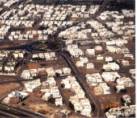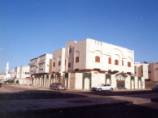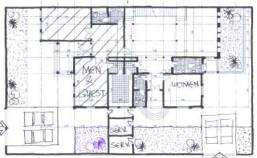|
Street space is a public property used by everyone with no preference to the area residents. As such, those residents no longer feel their ownership of the public space, but only have privacy within their own homes ( Figure25,26).
The private space is clearly seen within a house by its own residents, where privacy, as a cultural component, is still respected and required within the contemporary house structure. This could be seen in the segregation between guest and family rooms in addition to the private room used specially for women meetings. Moreover high walls are commonly used in private villas to prevent the visual intrusion of outsiders (Figure 27).
3- Conclusion: The goal of this research was to study how the house of Al-Madina Al-Monawarah, expresses the socio-economic changes in new forms and patterns. However, it is noticed that the research outcome can also be applicable to everyday environmental design problems in different cultures, since cultures all over the world undergo stages of transition from small stable societies to large technologically developed ones however, all cities and urban structures in such societies are affected on the long term with their social and economic changes, as they take place gradually without sudden changes as those happening in Al-Madina Al-Monawarah. There, fast and sudden economic development took place among its residents, who increased tremendously, in addition to the increased numbers of Pilgrims and Omra visitors. This research has clarified the contradiction between the traditional and modern approaches of house designs in Al-Madina Al-Monawarah. As economic and technological developments have direct implications on the cultural / environmental relations, the problem faced here is how can new houses and communities be designed in a way that will be compatible with the social and ethnic heritage without creating any turbulence in cultures. Here it is assumed that the growing of globalization and standardization in home design could encourage the social segregation. |
Urban Planners and Designers should appreciate the potential of creating urbanity. The urban fabric, as a whole, should create the possibility of accidental contact, confrontation and discoveries of the different. It is, therefore, essential for any designer to understand the sensitive or relative culture / environment and its gradual application in the design process, which can be facilitated by broadening the base of user or home owner participation in the process. As such, this research supports an open-ended design, rather than sticking to a limited framework. But, it is still argued that there are four main urban components that are related to Al-Madina’s culture: Privacy, people tendency to live in homogenous groups, good neighbourhood, and finally the dominance of the Mosque upon the urban fabric and visual image. It is also very important to provide environmental education to new generations. This education will help them in their adjustment to new environment settings, facilities, and changes, by showing them that these are in fact responsive to their cultural values, practices and above all needs.
References: 1. Al-Madina Al-Monawarah Authority, Al-Madina Al-Monawarah Regional Plan–First Report 2000. 2. Atlas of Saudi cities, Agency of the Ministry of Local Affairs for city planning. 3. Abdel Aziz El Kaaky, Al-Madina Al-Monawarah Between Architecture and History 2nd volume, Saudi Company for Printing and Distribution, 1999. 4. Al Hajj Ministry, Al-Madina Al-Monawarah Branch, Haj and Omara Statistics, 1997. 5. Al Hussayen M. Characteristics of Al Ahwash Urban Pattern in Al-Madina Al-Monawarah, the Magazine of King Saud University, Fourth Part, 1992. 6. Al-Madina Al-Monawarah Authority, Instructions Planner, 1993. 7. Bianca,S Urban Form in the Arab World. Past and Present. Thomas and Hudson, 2000. 8. Saleh Lamei, Al-Madina Al-Monawarah: Its Urban Development and Architectural Heritage, Al Nahda El Arabia Press, 1981. 9. Altmass, I; Chamers M., culture and Environment Cambridge University Press, 1980. 10. R. Amos, Archit and Comfort / Archit and Behaviours, 1980. 11. R. Amos, Human Aspect of Urban Form, Pergamon Press, 1977. |
||||
| << Prev. |


